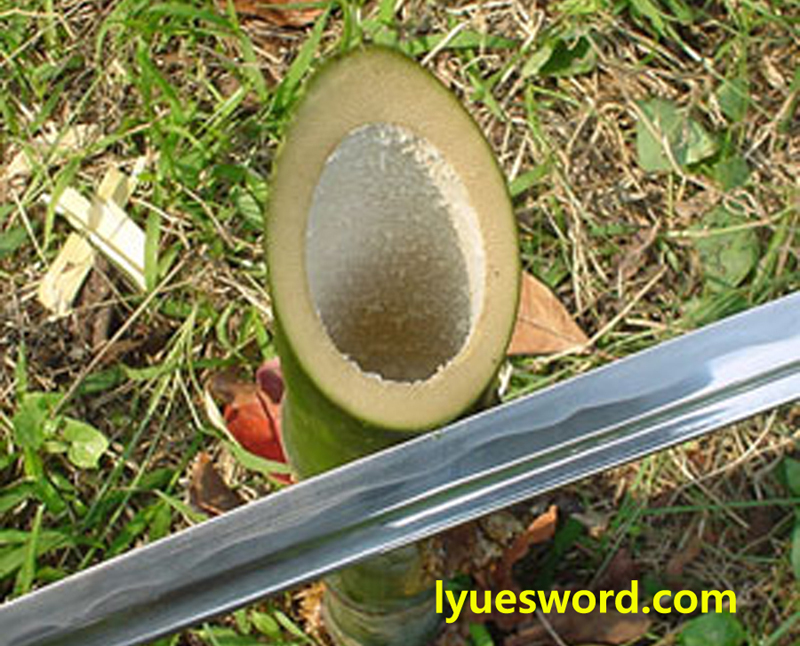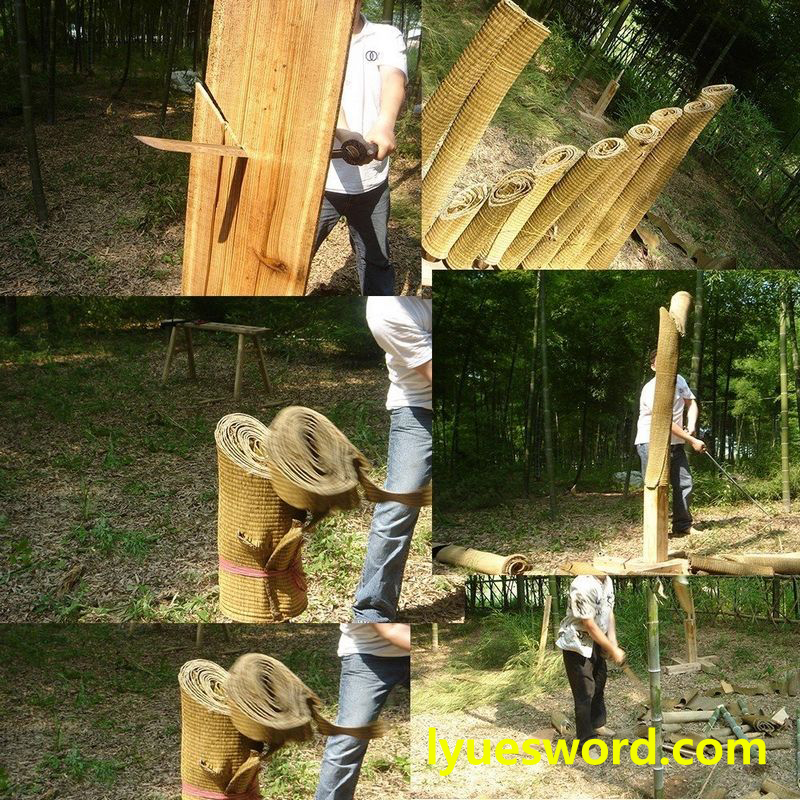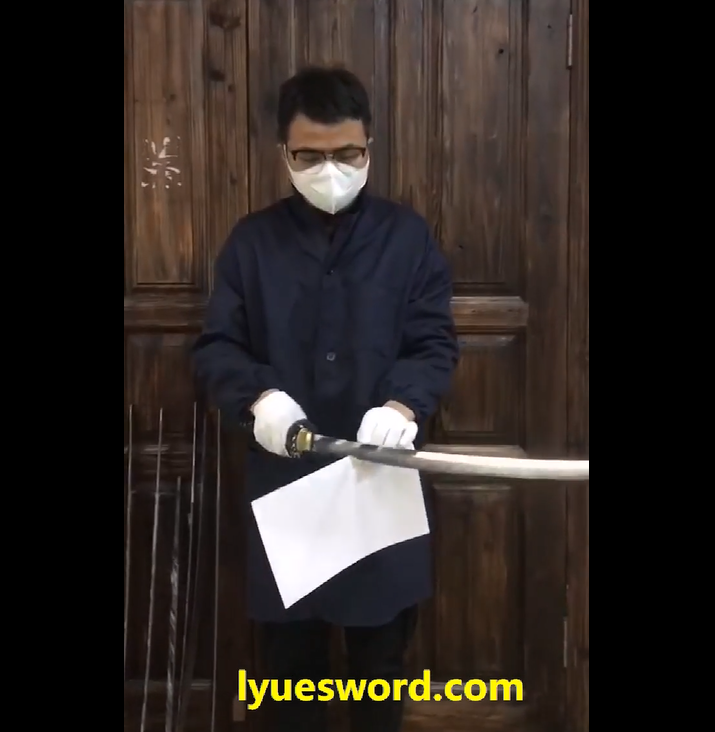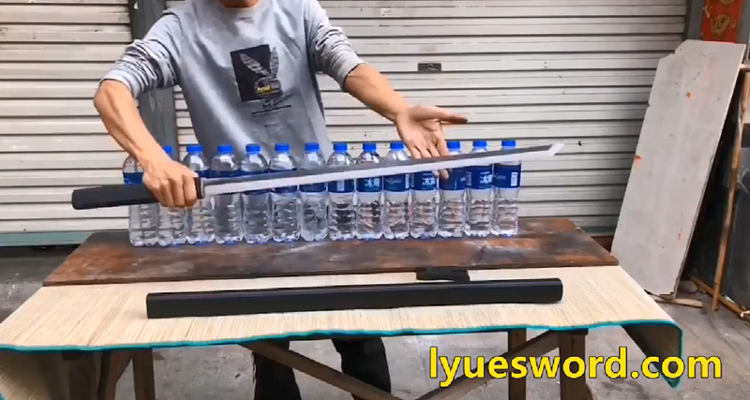By lyuesword | 04 December 2020 | 0 Comments
Traditional cutting targets for Japanese swords
Test cutting became widespread from the Edo period in Japan for testing the quality of swords. There were a variety of cuts that could be done, bamboo and tatami mats are the two main cutting targets, the below are several traditonal cutting targets for Japanese swords.
1) Tatami mats or goza
Tameshigiri has origins dating back to Japan's Edo period. Now, tameshigiri is performed to test the swordsmans's ability. Quite expensive (typically around $10 a mat) tatami mats or goza (the top layer of tatami mats) are the most traditional target, and cutting them with a set pattern of moves is known in JSA (Japanese Sword Arts) as 'Tameshigiri'. The tatami is rolled into a tune-like shape, and in some cases, soaked with water to make it denser and more difficult to cut through.

2) Fresh green bamboo
When testing the Japanese sword, a fresh green bamboo is believed to simulate the thickness and consistency of human bone which has also seen some popularity with the Western Martialarts (WMA) community. Old and yellowed bamboo is extremely tough which is not suitable for cutting targets.

3) Straw beach mats
Straw beach mats are another ‘poor mans tatami mats’ due to their easy availability in the summer months and low per unit price. Unfortunately, it takes approximately 3-4 rolled beach mats to equal the mass of a single rolled Tatami—and the Tatami is still stiffer.

4) Papers
A normal paper is not a bad substitute for tatami and has a similar consistency that tends not to scratch or damage the blade. There are basically two ways of using a paper for test cutting - rolled up soaked paper or a single piece of paper. You need a very sharp blade and a lightning fast movement when cutting a piece of paper without tearing it, demonstrating the practitioner's skill.

5) Water filled plastic bottles
It also takes a fairly quick cut because if your strike is too slow, all that happens is that you will bat them across the yard like a baseball.

Good technique and correct edge alignment is important, but anyone can become proficient cutting targets with Japanese swords in only a few swings if the basic foundation is good.
Want a unique sword? Feel free to contact us:
Email: lyuesword@hotmail.com
Website: www.lyuesword.com
Custom Sword Page: www.lyuesword.com/Custom-Sword/customization-options/Create-Your-Own-Swords
1) Tatami mats or goza
Tameshigiri has origins dating back to Japan's Edo period. Now, tameshigiri is performed to test the swordsmans's ability. Quite expensive (typically around $10 a mat) tatami mats or goza (the top layer of tatami mats) are the most traditional target, and cutting them with a set pattern of moves is known in JSA (Japanese Sword Arts) as 'Tameshigiri'. The tatami is rolled into a tune-like shape, and in some cases, soaked with water to make it denser and more difficult to cut through.

2) Fresh green bamboo
When testing the Japanese sword, a fresh green bamboo is believed to simulate the thickness and consistency of human bone which has also seen some popularity with the Western Martialarts (WMA) community. Old and yellowed bamboo is extremely tough which is not suitable for cutting targets.

3) Straw beach mats
Straw beach mats are another ‘poor mans tatami mats’ due to their easy availability in the summer months and low per unit price. Unfortunately, it takes approximately 3-4 rolled beach mats to equal the mass of a single rolled Tatami—and the Tatami is still stiffer.

4) Papers
A normal paper is not a bad substitute for tatami and has a similar consistency that tends not to scratch or damage the blade. There are basically two ways of using a paper for test cutting - rolled up soaked paper or a single piece of paper. You need a very sharp blade and a lightning fast movement when cutting a piece of paper without tearing it, demonstrating the practitioner's skill.

5) Water filled plastic bottles
It also takes a fairly quick cut because if your strike is too slow, all that happens is that you will bat them across the yard like a baseball.

Good technique and correct edge alignment is important, but anyone can become proficient cutting targets with Japanese swords in only a few swings if the basic foundation is good.
Want a unique sword? Feel free to contact us:
Email: lyuesword@hotmail.com
Website: www.lyuesword.com
Custom Sword Page: www.lyuesword.com/Custom-Sword/customization-options/Create-Your-Own-Swords
Leave a Reply
Your email address will not be published.Required fields are marked. *